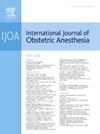气动腿部加压对剖宫产时通过变速输注预防低血压的苯肾上腺素剂量的影响:非盲随机对照试验
IF 2.6
3区 医学
Q2 ANESTHESIOLOGY
引用次数: 0
摘要
背景建议在剖宫产(CD)过程中输注苯肾上腺素以预防脊柱低血压,但可能会产生剂量依赖性副作用。我们假设,在输注可变速率的苯肾上腺素的同时对小腿进行间歇性气压按压(IPC),可减少 CD 期间所需的苯肾上腺素剂量。脊髓麻醉后,IPC 组开始对小腿进行 IPC,所有女性均接受苯肾上腺素输注,输注量从 25 μg-min-1 开始,以 16.7 μg-min-1 为基线增加收缩压(SAP)< 90%。如果出现低血压(SAP 大于 80% 基线),则注射 100 μg 苯肾上腺素。结果IPC组每分钟的苯肾上腺素剂量(34.4 ± 7.3 μg-min-1 vs. 40.9 ± 9.5 μg-min-1,P = 0.001;平均差异-6.6 μg-min-1,95% CI -10.5 to -2.7 μg-min-1)和低血压发生率(24% vs. 55%,P = 0.005)均低于对照组。两组的苯肾上腺素总剂量无明显差异(603.2 ± 217.1 μg vs. 706.2 ± 247.5 μg,P = 0.058;平均差异 -102.9 μg,95% CI -209.4 to 3.结论间歇性气压加压结合可变速率的苯肾上腺素输注降低了每分钟的苯肾上腺素剂量和脊髓麻醉下 CD 期间低血压的发生率。本文章由计算机程序翻译,如有差异,请以英文原文为准。
Effect of pneumatic leg compression on phenylephrine dose for hypotension prophylaxis via variable rate infusion at cesarean delivery: an unblinded randomized controlled trial
Background
Phenylephrine infusion is recommended to prevent spinal hypotension during cesarean delivery (CD) but may be associated with dose-dependent side effects. We hypothesized that adding intermittent pneumatic compression (IPC) of the lower legs to a variable-rate phenylephrine infusion will reduce the dose of phenylephrine required during CD.
Methods
Seventy-six healthy women undergoing elective CD under combined spinal-epidural anesthesia were randomly assigned to IPC or control groups (n = 38 per group). After spinal anesthesia, IPC of the lower legs was initiated in the IPC group, and all women received a phenylephrine infusion starting at 25 μg·min−1 and increasing by 16.7 μg·min−1 for systolic blood pressure (SAP) < 90% baseline. If hypotension (SAP < 80% baseline) occurred, 100 μg phenylephrine bolus was administered. The primary outcome was the dose of phenylephrine per minute.
Results
The dose of phenylephrine per minute (34.4 ± 7.3 μg·min−1 vs. 40.9 ± 9.5 μg·min−1, P = 0.001; mean difference −6.6 μg·min−1, 95% CI −10.5 to −2.7 μg·min−1) and the incidence of hypotension (24% vs. 55%, P = 0.005) were lower in the IPC group than in the control group. There were no significant differences between the two groups in the total dose of phenylephrine (603.2 ± 217.1 μg vs. 706.2 ± 247.5 μg, P = 0.058; mean difference −102.9 μg, 95% CI −209.4 to 3.5 μg), maternal side effects, or neonatal outcomes.
Conclusions
Intermittent pneumatic compression combined with a variable-rate phenylephrine infusion reduced the phenylephrine dose per minute and the incidence of hypotension during CD under spinal anesthesia.
求助全文
通过发布文献求助,成功后即可免费获取论文全文。
去求助
来源期刊
CiteScore
4.70
自引率
7.10%
发文量
285
审稿时长
58 days
期刊介绍:
The International Journal of Obstetric Anesthesia is the only journal publishing original articles devoted exclusively to obstetric anesthesia and bringing together all three of its principal components; anesthesia care for operative delivery and the perioperative period, pain relief in labour and care of the critically ill obstetric patient.
• Original research (both clinical and laboratory), short reports and case reports will be considered.
• The journal also publishes invited review articles and debates on topical and controversial subjects in the area of obstetric anesthesia.
• Articles on related topics such as perinatal physiology and pharmacology and all subjects of importance to obstetric anaesthetists/anesthesiologists are also welcome.
The journal is peer-reviewed by international experts. Scholarship is stressed to include the focus on discovery, application of knowledge across fields, and informing the medical community. Through the peer-review process, we hope to attest to the quality of scholarships and guide the Journal to extend and transform knowledge in this important and expanding area.

 求助内容:
求助内容: 应助结果提醒方式:
应助结果提醒方式:


